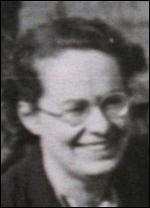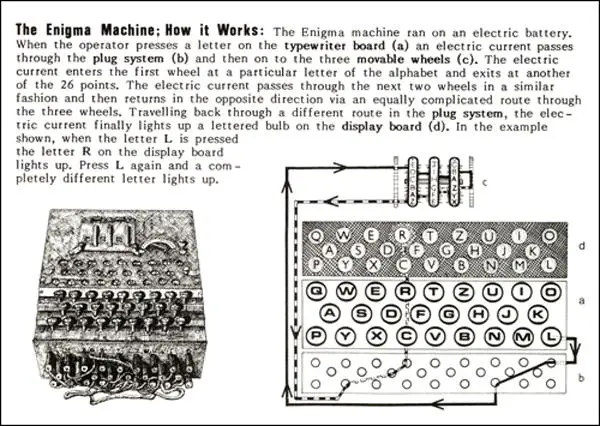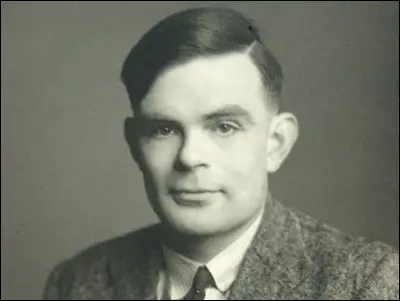Joan Clarke

Joan Clarke, the daughter of William Clarke, a clergyman, and Dorothy Clarke, was born in London on 24th June 1917. After being educated at Dulwich High School she studied Mathematics at Newnham College. Joan graduated in 1939, achieving a double first in Mathematics. She was also awarded the Philippa Fawcett Prize and the Helen Gladstone Scholarship. (1)
On the outbreak of the Second World War, one of her tutors, Gordon Welchman, recruited Joan Clarke to work for the Government Code and Cypher School based at Bletchley Park. Bletchley was selected simply as being more or less equidistant from Oxford University and Cambridge University since the Foreign Office believed that university staff made the best cryptographers. The house itself was a large Victorian Tudor-Gothic mansion, whose ample grounds sloped down to the railway station. (2)
During the Second World War radio communication was a vital aspect of modern warfare. Radio was used for aerial, naval and mobile land warfare. However, it was very important that the enemy was not aware of these messages. Therefore all radio communications had to be disguised. The main task of the codebreakers was to read messages being sent by the German Enigma Machine. The situation was explained by Francis Harry Hinsley: "By 1937 it was established that... the German Army, the German Navy and probably the Air Force, together with other state organisations like the railways and the SS used, for all except their tactical communications, different versions of the same cypher system - the Enigma machine which had been put on the market in the 1920s but which the Germans had rendered more secure by progressive modifications." (3)
Bletchley Park
Peter Calvocoressi, explained in his book, Top Secret Ultra (1980), the task that faced the codebreakers. "Although its keyboard was simpler than a typewriter's, the Enigma machine was in all other respects much more complicated. Behind the keyboard the alphabet was repeated in another three rows and in the same order, but this time the letters were not on keys but in small round glass discs which were set in a flat rectangular plate and could light up one at a time. When the operator struck a key one of these letters lit up. But it was never the same letter. By striking P the operator might, for example, cause L to appear; and next time he struck P he would get neither P nor L but something entirely different. This operator called out the letters as they appeared in lights and a second operator sitting alongside him noted them down. This sequence was then transmitted by wireless in the usual Morse code and was picked up by whoever was supposed to be listening for it."

Both the person sending and receiving the message had a handbook that told him what he had to do each day. This included the settings of the machine. As Calvocoressi pointed out: "These parts or gadgets consisted of a set of wheels rotors and a set of plugs. Their purpose was not simply to turn P into L but to do so in so complex a manner that it was virtually impossible for an eavesdropper to find out what had gone on inside the machine in each case. It is quite easy to construct a machine that will always turn P into L, but it is then comparatively easy to find out that L always means P; a simple substitution of this kind is inadequate for specially secret traffic. The eavesdropper's basic task was to set his machine in exactly the same way as the legitimate recipient of the message had set his, since the eavesdropper would then be able to read the message with no more difficulty than the legitimate recipient. The more complex the machine and its internal workings, the more difficult and more time-consuming was it for the eavesdropper to solve this problem.... Although only three wheels could be inserted into the machine at any one time, there were by 1939 five wheels issued with each machine. The operator had to use three of this set of five. He had to select the correct three and then place them in a prescribed order. This was crucial because the wheels, although outwardly identical, were differently wired inside." (4)
If you find this article useful, please feel free to share on websites like Reddit. You can follow John Simkin on Twitter, Google+ & Facebook or subscribe to our monthly newsletter.
Joan Clarke's biographer, Lynsey Ann Lord, has pointed out that records "describe Clarke as congenial but shy, gentle and kind, non-aggressive and always subordinate to the men in her life; qualities that would allow her to conform within the male dominated world of Bletchley Park." At first she was engaged in routine clerical work. "Clarke was originally paid £2 a week - but as this was an era of female discrimination in the workplace, similarly qualified men received significantly more money." (5) Her abilities were soon recognised and in order to give her higher pay she was promoted to the rank of linguist. "The principle of equal pay and rank being stoutly resisted by the civil service, she had to be promoted to the humble rank of linguist that the pre-war establishment reserved for women." (6)
Alfred Dilwyn Knox, a senior figure at the the Government Code and Cypher School admitted that he liked employing women. This included Mavis Batey and Margaret Rock. According to Sinclair McKay, the author of The Secret Life of Bletchley Park (2010): "Dilwyn Knox... found that women had a greater aptitude for the work required - as well as nimbleness of mind and capacity for lateral thought, they possessed a care and attention to detail that many men might not have had. This of course is just speculation; the other possibility, and one that seems likely considering the scratchiness of many of Knox's personal dealings, was that he simply did not like men very much." (7)
Joan Clarke & Alan Turing
In June 1940 Joan Clarke went to work for Alan Turing in Hut 8. Joan later recalled: "I can remember Alan Turing coming in as usual for a day's leave, doing his own mathematical research at night, in the warmth and light of the office, without interrupting the routine of daytime sleep." (8) The two quickly developed a close relationship. He found her intellectually satisfying as she was able to discuss papers he had written. They were also both keen on chess and although Joan had only recently learnt to play, they were quite well matched. "As they only had a cardboard pocket set, and proper pieces were unobtainable in wartime conditions, so they improvised their own solution. Alan got some clay from one of the local pits, and they modelled the figures together. Alan then fired them on the hob of the coal fire in his room at the Crown Inn. The resulting set was quite usuable, if somewhat liable to breaking. He also tried to make a one-valve wireless set, telling her about the one he had made at school, but this was not such a success." (9)

Alan Turing eventually proposed marriage and Joan Clarke gladly accepted. (10) Nigel Cawthorne, the author of The Enigma Man (2014) suggests that "Turing was not much of a catch... Sometimes he appeared in the office in his pyjamas, or wore trousers held up by a striped necktie instead of a belt. His hair was unkempt and he had a permanent five o'clock shadow, refusing to shave with anything but an ancient electric razor. Though he did not smoke, his teeth were yellow and he bit his fingernails. He was also a workaholic." (11)
A few days later he told her that the marriage might have problems as he had "homosexual tendencies." (12) Clarke's biographer, Lynsey Ann Lord, has argued: "To understand her decision to continue with the engagement following his disclosure, it has to be made clear that during this period in history, marriage for many women, was considered a social duty and it was not necessary that marriage should correspond with sexual desires." Alan Hodges agrees and claims that "many people, in 1941, would not have thought it important that marriage did not correspond with his sexual desires; the idea that marriage should include a mutual sexual satisfaction was still a modern one, which had not yet replaced the older idea of marriage as a social duty. One thing that Alan never questioned was the form of the marriage relationship, with the wife as housekeeper." (13)
The engagement was continued and he gave her a ring. Alan also took Joan to Guildford to meet his mother. They also had lunch with her parents, William and Dorothy Clarke. Alan told Joan about some of his homosexual relationships but claimed that this kind of behaviour was over. He even said that he would like them to have children. However, he eventually decided that he could not go through with the marriage and broke the relationship off. (14)
Joan Clarke - MBE
Joan Clarke became Deputy Head of Hut 8 in 1944 and remained in that post until the end of the war. In 1947, Clarke was appointed a Member of the British Empire (MBE) for her codebreaking expertise during the war. She continued working at the Government Code and Cypher School and in 1952 she married a colleague, Lieutenant-Colonel J. K R Murray. The couple did not have children. (15)
The Death of Alan Turing
Alan Turing wrote to Joan in February 1952 and admitted that he had been having sex with other men and that "he had been found out". Alan and Arnold Murray, a 19-year-old unemployed man, had both been charged with gross indecency under Section 11 of the Criminal Law Amendment Act 1885. (16)
Turing and Murray went on trial on 31st March 1952. Both men were found guilty. Murray was given a conditional discharge. Turing was placed on probation, which would be conditional on his agreement to undergo hormonal treatment designed to reduce his sex drive. He accepted the option of treatment via injections of stilboestrol, a synthetic oestrogen; this treatment was continued for the course of one year. Turing wrote to his friend, Philip Hall: "I am both bound over for a year and obliged to take this organo-therapy for the same period. It is supposed to reduce sexual urge whilst it goes on... The psychiatrists seemed to think it useless to try and do any psychotherapy." (17) The treatment rendered Turing impotent.
Turing's conviction led to the removal of his security clearance and barred him from continuing with his cryptographic consultancy for the Government Communications Headquarters (GCHQ). The case of the two Soviet spies, Guy Burgess and Donald Maclean, who were both homosexuals, convinced the authorities that Turing was a security risk and was forbidden to work on research projects relating to the development of the computer. (18) He was also denied entry into the United States.
At his home in Wilmslow he began making certain chemicals, among them potassium cyanide. On 7th June, 1954, Alan Turing coated an apple with some of the cyanide, went to bed and bit the apple and died. The coroner pronounced at the inquest: "I am forced to the conclusion that this was a deliberate action, for with a man of this type one can never be sure what his mental processes are going to do next. Here was a brilliant mathematician with unusual mental achievements. he might easily become unbalanced and unstable." (19)
Joan Murray lived in Scotland for many years but they returned to Cheltenham in 1962 and she rejoined the Government Communications Headquarters (GCHQ) where she remained until retiring at the age of 60 in 1977. In 1986, following the death of her husband, she moved to Headington, near Oxford.
Joan Clarke died aged 79 on 4th September 1996.
Primary Sources
(1) Joe Miller, BBC (10th November, 2014)
In 1939, Clarke was recruited into the Government Code and Cypher School (GCCS) by one of her supervisors at Cambridge, where she gained a double first in mathematics, although she was prevented from receiving a full degree, which women were denied until 1948.
As was typical for girls at Bletchley, (and they were universally referred to as girls, not women) Clarke was initially assigned clerical work, and paid just £2 a week - significantly less than her male counterparts.
Within a few days, however, her abilities shone through, and an extra table was installed for her in the small room within Hut 8 occupied by Turing and a couple of others.
Joan Clarke's ingenious work as a codebreaker during WW2 saved countless lives, and her talents were formidable enough to command the respect of some of the greatest minds of the 20th Century, despite the sexism of the time.
But while Bletchley Park hero Alan Turing - who was punished by a post-war society where homosexuality was illegal and died at 41 - has been treated more kindly by history, the same cannot yet be said for Clarke.
The only woman to work in the nerve centre of the quest to crack German Enigma ciphers, Clarke rose to deputy head of Hut 8, and would be its longest-serving member.
She was also Turing's lifelong friend and confidante and, briefly, his fiancée.
Her story has been immortalised by Keira Knightley in The Imitation Game, out in UK cinemas this week.
(2) Amanda Williams, The Daily Mail (23rd June, 2013)
A film about homosexual wartime codebreaker and father of modern computing Alan Turing has been attacked by his biographer.
Enigma hero Turing played a key role in breaking the German Enigma code during the Second World War while working at Bletchley Park. He is credited with saving thousands of lives during the conflict.
But a new American funded film about his life has been lambasted for exaggerating a love affair with a woman, played by Keira Knightley, and making a fictional connection to a notorious spy. Turing was a well known homosexual.
The Imitation Game is based on a biography by Andrew Hodges, an Oxford maths academic.
It is set to star Benedict Cumberbatch as Turing and fellow Bletchley codebreaker Joan Clarke will be played by Keira Knightley as Turing's girlfriend - despite the fact that he was gay.
The Sunday Times reports that Mr Hodges has been sent a script of the film and is "alarmed by the inaccuracies it".
He said: "They have built up the relationship with Joan much more than it actually was."
He said while the couple had been "briefly engaged", it was said that he liked her because he could talk to her as if she were really another man and there had never been much physical contact.
He said the casting of Keira Knightley in the role, did not "strike him as right."
He said: 'I'm not being rude about her, but Joan Clarke was no glamourpuss.'
The film follows the break-up of their relationship, which happened because Turing was unable to live a lie by marrying her.
But Hodges is said to be more concerned about the main story line, which invents a fictional relationship between Turing and John Cairncross, who was later identified as the fifth man in the British spy ring that included Kim Philby and Guy Burgess.
People who worked on separate projects at Bletchley were kept apart and Hodges labeled the scenario 'ludicrous' adding that Turing and Cairncross would never have met.
He said: "Their relationship is invented."
The paper reports that a line in the script, which sees Turing confronted by a colleague who tells him "No wonder they think you are a spy", has now been removed.
The film was written by Graham Moore and is to be directed by the Norwegian Morten Tyldum whose last production was the violent thriller Headhunters, and produced by Teddy Schwarzmann.
Hodges is said to have written to Mr Moore about his concerns about the script, including criticisms that it showed nothing of Turing's 'extraordinary skills as a scientist and computer designer'.
He said he was told they were going to make more of his marathon running and see him having more interaction with colleagues to make him look less wimpish.
Mr Schwarzmann said the film was a drama, not a piece of entertainment and added while they do not want to invent events, there are some "creative liberties".
He added: "When we come over, we are also going to get in touch with some other experts on that period. We know how very important Turing is to you over there."
